The Collaborative Optimization of the Discharge Pressure and Heat Recovery Rate in a Transcritical CO2 Heat Pump Used in Extremely Low Temperature Environment
Abstract
1. Introduction
2. The Establishment of the Simulation Model
2.1. The Transcritical CO2 Thermal Management System
2.2. The Simulation Model
2.2.1. Compressor Model
2.2.2. Gas-Cooler Model and IHX Model
2.2.3. Evaporator Model
2.2.4. Design Specifications
2.2.5. Parameters Used in the Analysis
2.3. Methodology
3. Results and Discussion
3.1. The Thermodynamic Characteristics with the Discharge Pressure
3.2. The Thermodynamic Characteristics with the Heat Recovery Rate
3.3. The Collaborative Optimization of the Discharge Pressure and Heat Recovery Rate
4. Conclusions
- In a typical transcritical CO2 heat pump system, there are two optimizable parameters that affect the system performance significantly, which are the heat recovery rate and the discharge pressure, where higher or lower values of these two parameters will definitely cause a deterioration in the system performance.
- There is a very complicated coupling relationship between the heat recovery rate and the discharge pressure. The actual values of these two parameters would significantly affect the optimal values of each other, thus, these two optimizable parameters should be optimized collaboratively.
- The optimal value of the system heating COP was better under a higher heat recovery rate and a relatively lower discharge pressure, which is why these kinds of operating conditions are highly recommended from the perspective of the collaborative optimization of the discharge pressure and heat recovery rate.
- The heat recovery rate had a positive effect on the system performance when the discharge pressure was lower than its optimal value, while the heat recovery rate presented a passive effect on the system performance when the discharge pressure was higher than its optimal value.
Author Contributions
Funding
Data Availability Statement
Conflicts of Interest
Nomenclature
| A | Heat transfer area (m2) | v | Volumetric |
| V | Volume (m3) | dis | Displacement |
| N | Rotary speed (rev∙min−1) | s | Suction |
| h | Enthalpy (kJ∙kg−1) | is | Isentropic |
| K | Heat transfer coefficient (W∙K−1∙m−2) | m | Mechanical |
| Mass flow rate (kg∙s−1) | d | Discharge | |
| P | Power consumption (J) | hx | Heat exchanger |
| Heat transfer coefficients (W∙K−1∙m−2) | eva | Evaporate | |
| T | Temperature (°C) | w | Water |
| Quantity of heat (W) | i | Inside | |
| Density (kg∙m−3) | j | Parameter at cell level | |
| Efficiency | W | Wall | |
| Re | Reynolds number | p | Pressure |
| Nu | Nusselt number | r | Refrigerant |
| Pr | Prandtl number | eq | Equivalent |
| M | Molecular weight (kg·kmol−1) | L | Liquid |
| Moisture separation coefficient///Heat recovery rate | nb | Nucleate boiling | |
| S | limiting factor of nucleate boiling heat transfer coefficient | cb | Convection boiling |
| Thermal coefficient (kW·(K·m)−1) | Liquid film thickness | ||
| D/d | Diameter(m) | o | Outside |
| Liquid film thickness (m) |
References
- Xu, Y.; Mao, C.; Huang, Y.; Shen, X.; Xu, X.; Chen, G. Performance evaluation and multi-objective optimization of a low-temperature CO2 heat pump water heater based on artificial neural network and new economic analysis. Energy 2021, 216, 119232. [Google Scholar] [CrossRef]
- Stene, J. CO2 Heat pump system for space heating and hot water heating in low-energy houses and passive houses. In Proceedings of the 1st Nordic Passive House Conference Passivhus Norden, Trondheim, Norway, 2–3 April 2008; Volume 36. [Google Scholar]
- Song, Y.; Cui, C.; Li, M.; Cao, F. Investigation on the effects of the optimal medium-temperature on the system performance in a transcritical CO2 system with a dedicated transcritical CO2 subcooler. Appl. Therm. Eng. 2020, 168, 114846. [Google Scholar] [CrossRef]
- Song, Y.; Ye, Z.; Wang, Y.; Cao, F. The experimental verification on the optimal discharge pressure in a subcooler-based transcritical CO2 system for space heating. Energy Build 2018, 158, 1442–1449. [Google Scholar] [CrossRef]
- Cao, F.; Song, Y.; Li, M. Review on development of air source transcritical CO2 heat pump systems using direct-heated type and recirculating-heated type. Int. J. Refrig. 2019, 104, 455–475. [Google Scholar] [CrossRef]
- Rony, R.U.; Yang, H.; Krishnan, S.; Song, J. Recent advances in transcritical CO2 (R744) heat pump system: A review. Energies 2019, 12, 457. [Google Scholar] [CrossRef]
- Assad, M.E.H.; Aryanfar, Y.; Javaherian, A.; Khosravi, A.; Aghaei, K.; Hosseinzadeh, S.; Pabon, J.; Mahmoudi, S.M.S. Energy, exergy, economic and exergoenvironmental analyses of transcritical CO2 cycle powered by single flash geothermal power plant. Int. J. Low-Carbon Technol. 2021, 16, 1504–1518. [Google Scholar] [CrossRef]
- Lorentzen, G.; Pettersen, J. A new, efficient and environmentally benign system for car air-conditioning. Int. J. Refrig. 1993, 16, 4–12. [Google Scholar] [CrossRef]
- Chen, Y.; Gu, J. The optimum high pressure for CO2 transcritical refrigeration systems with internal heat exchangers. Int. J. Refrig. 2005, 28, 1238–1249. [Google Scholar] [CrossRef]
- Kauf, F. Determination of the optimum high pressure for transcritical CO2 refrigeration cycles. Int. J. Therm. 1999, 38, 325–330. [Google Scholar] [CrossRef]
- Liao, S.M.; Zhao, T.S.; Jakobsen, A. A correlation of optimal heat rejection pressures in transcritical carbon dioxide cycles. Appl. Therm. Eng. 2000, 20, 831–841. [Google Scholar] [CrossRef]
- Sarkar, J.; Bhattacharyya, S.; Gopal, M.R. Optimization of a transcritical CO2 heat pump cycle for simultaneous cooling and heating applications. Int. J. Refrig. 2004, 27, 830–838. [Google Scholar] [CrossRef]
- Aprea, C.; Maiorino, A. Heat rejection pressure optimization for a carbon dioxide split system: An experimental study. Appl. Energy 2009, 86, 2373–2380. [Google Scholar] [CrossRef]
- Cabello, R.; Sanchez, D.; Llopis, R.; Torrella, E. Experimental evaluation of the energy efficiency of a CO2 refrigerating plant working in transcritical conditions. Appl. Therm. Eng. 2008, 28, 1596–1604. [Google Scholar] [CrossRef]
- Nguyen, A.; Eslami-Nejad, P.; Badache, M.; Bastani, A. Influence of an internal heat exchanger on the operation of a CO2 direct expansion ground source heat pump. Energy Build. 2019, 202, 109343. [Google Scholar] [CrossRef]
- Aprea, C.; Greco, A.; Maiorino, A. The substitution of R134a with R744: An exergetic analysis based on experimental data. Int. J. Refrig. 2013, 36, 2148–2159. [Google Scholar] [CrossRef]
- Wang, Z.; Han, F.; Sundén, B. Parametric evaluation and performance comparison of a modified CO2 transcritical refrigeration cycle in air-conditioning applications. Chem. Eng. Res. Des. 2018, 131, 617–625. [Google Scholar] [CrossRef]
- Ituna-Yudonago, J.F.; Belman-Flores, J.M.; Elizalde-Blancas, F.; García-Valladares, O. Numerical investigation of CO2 behavior in the internal heat exchanger under variable boundary conditions of the transcritical refrigeration system. Appl. Therm. Eng. 2017, 115, 1063–1078. [Google Scholar] [CrossRef]
- Cao, F.; Wang, Y.; Ye, Z. Theoretical analysis of internal heat exchanger in transcritical CO2 heat pump systems and its experimental verification. Int. J. Refrig. 2019, 106, 506–516. [Google Scholar] [CrossRef]
- Luger, C.; Rieberer, R. Multi-objective design optimization of a rail HVAC CO2 cycle. Int. J. Refrig. 2018, 92, 133–142. [Google Scholar] [CrossRef]
- Dang, C.; Hihara, E. In-tube cooling heat transfer of supercritical carbon dioxide. Part 1. Experimental measurement. Int. J. Refrig. 2004, 27, 736–747. [Google Scholar] [CrossRef]
- Dang, C.; Hihara, E. In-tube cooling heat transfer of supercritical carbon dioxide. Part 2. Comparison of numerical calculation with different turbulence models. Int. J. Refrig. 2004, 27, 748–760. [Google Scholar] [CrossRef]
- Cheng, L.; Ribatski, G.; Wojtan, L.; Thome, J.R. New flow boiling heat transfer model and flow pattern map for carbon dioxide evaporating inside horizontal tubes. Int. J. Heat Mass Transf. 2006, 49, 4082–4094. [Google Scholar] [CrossRef]
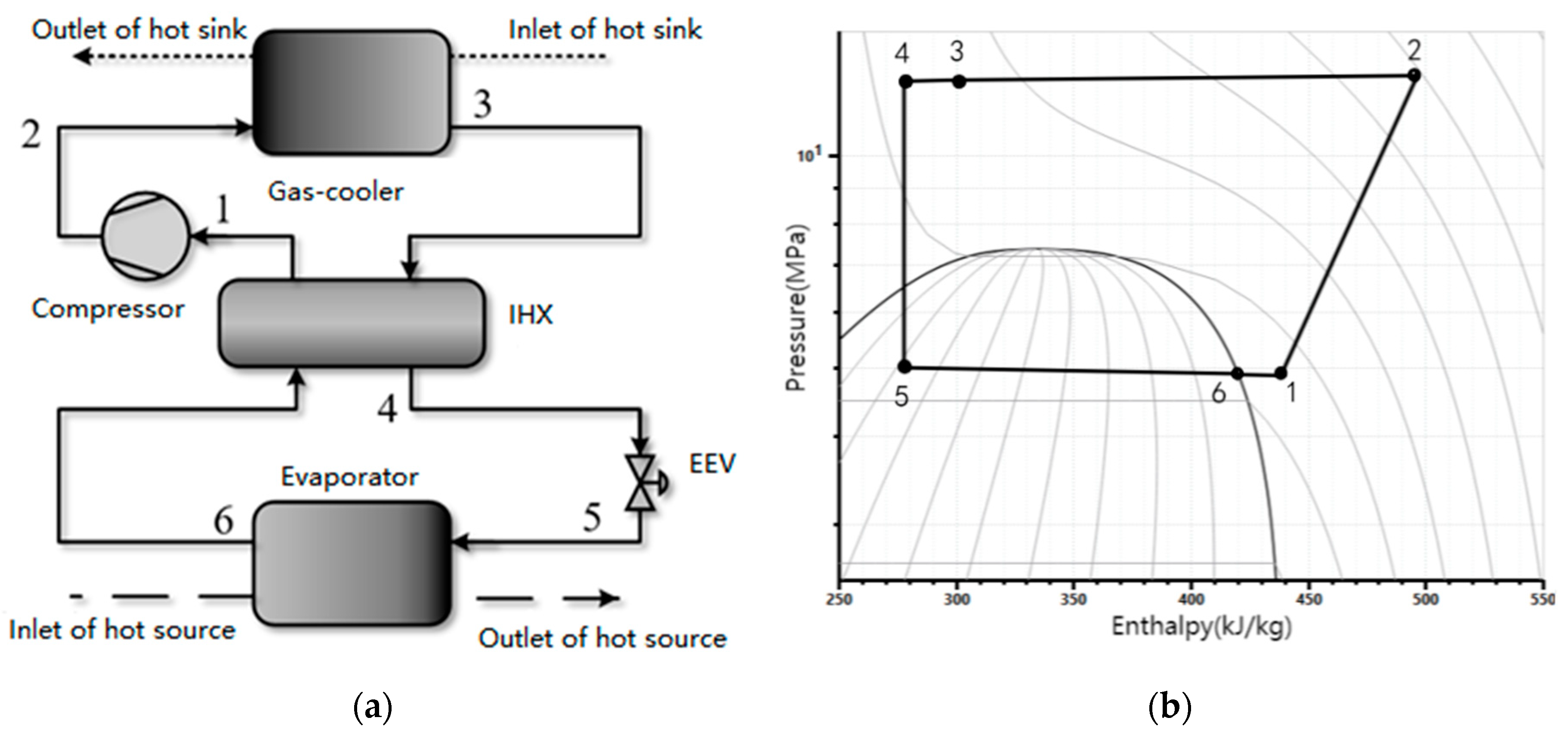
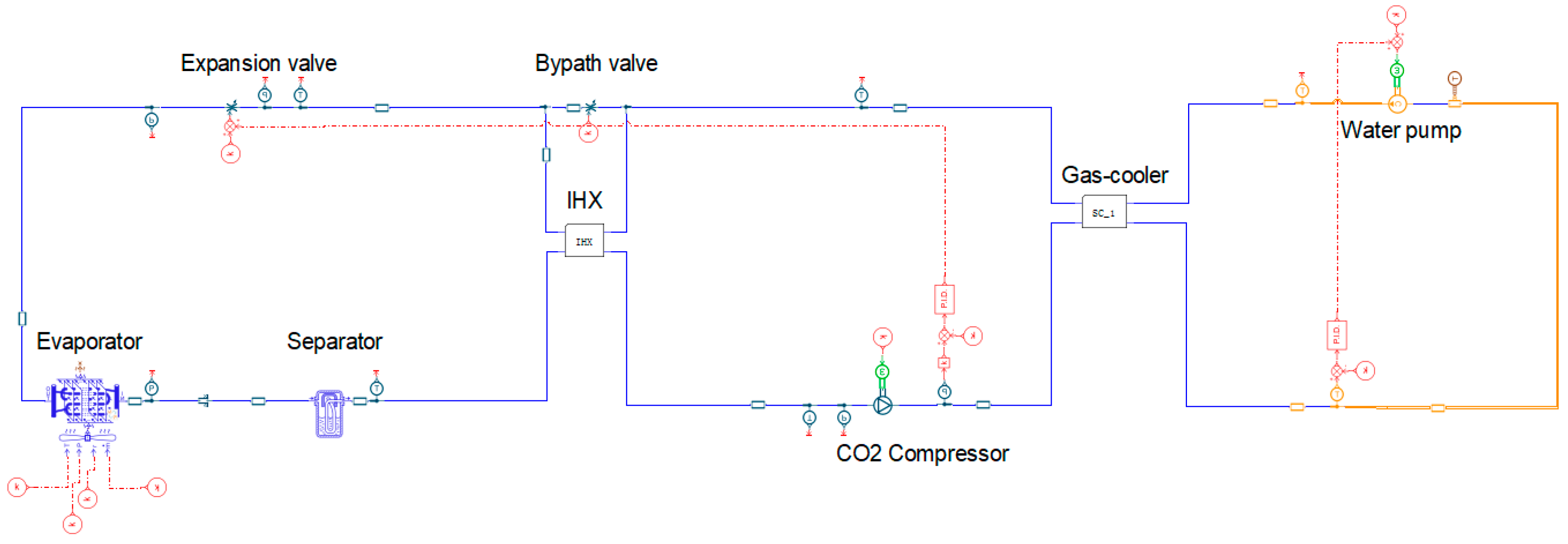
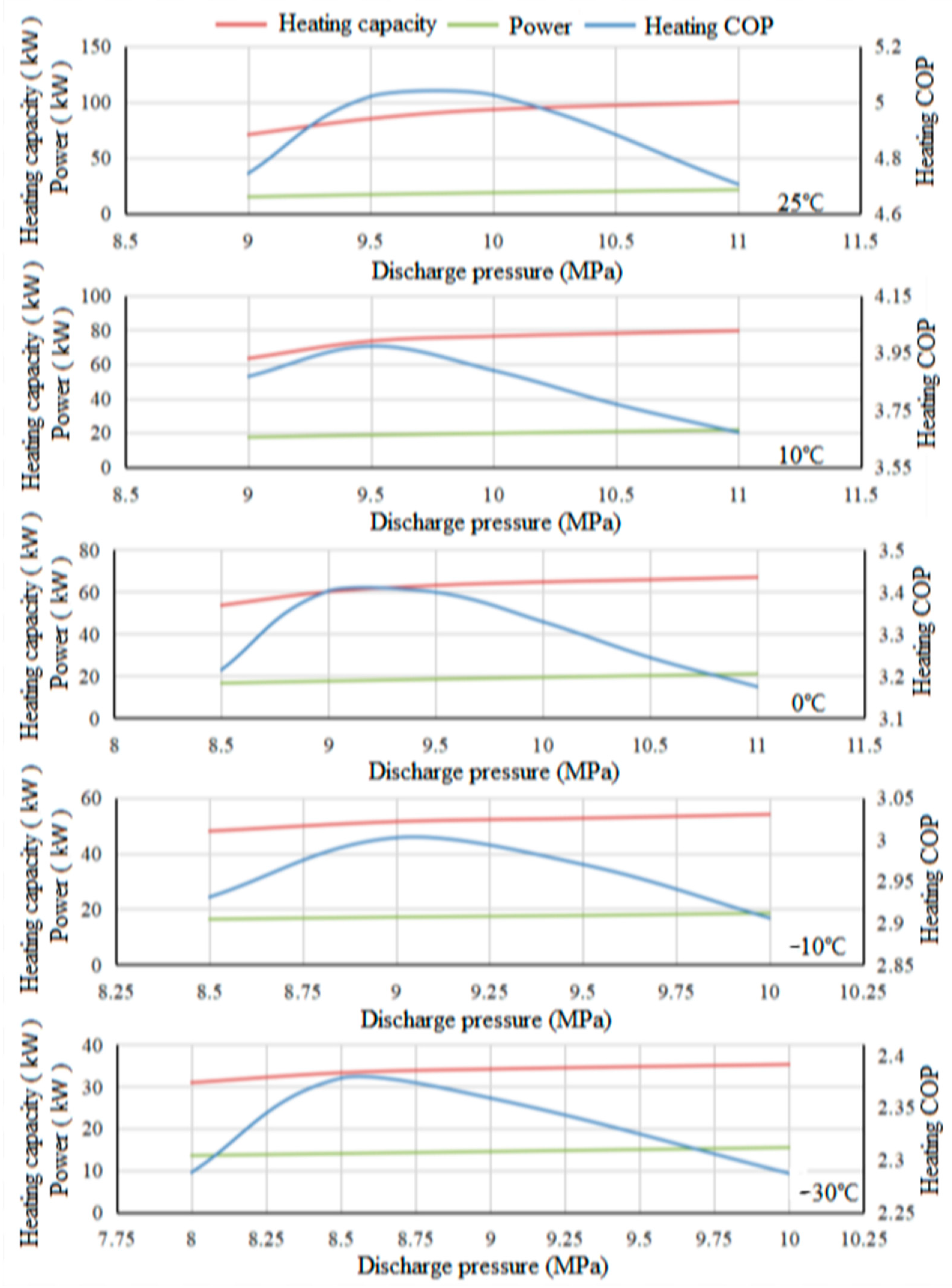
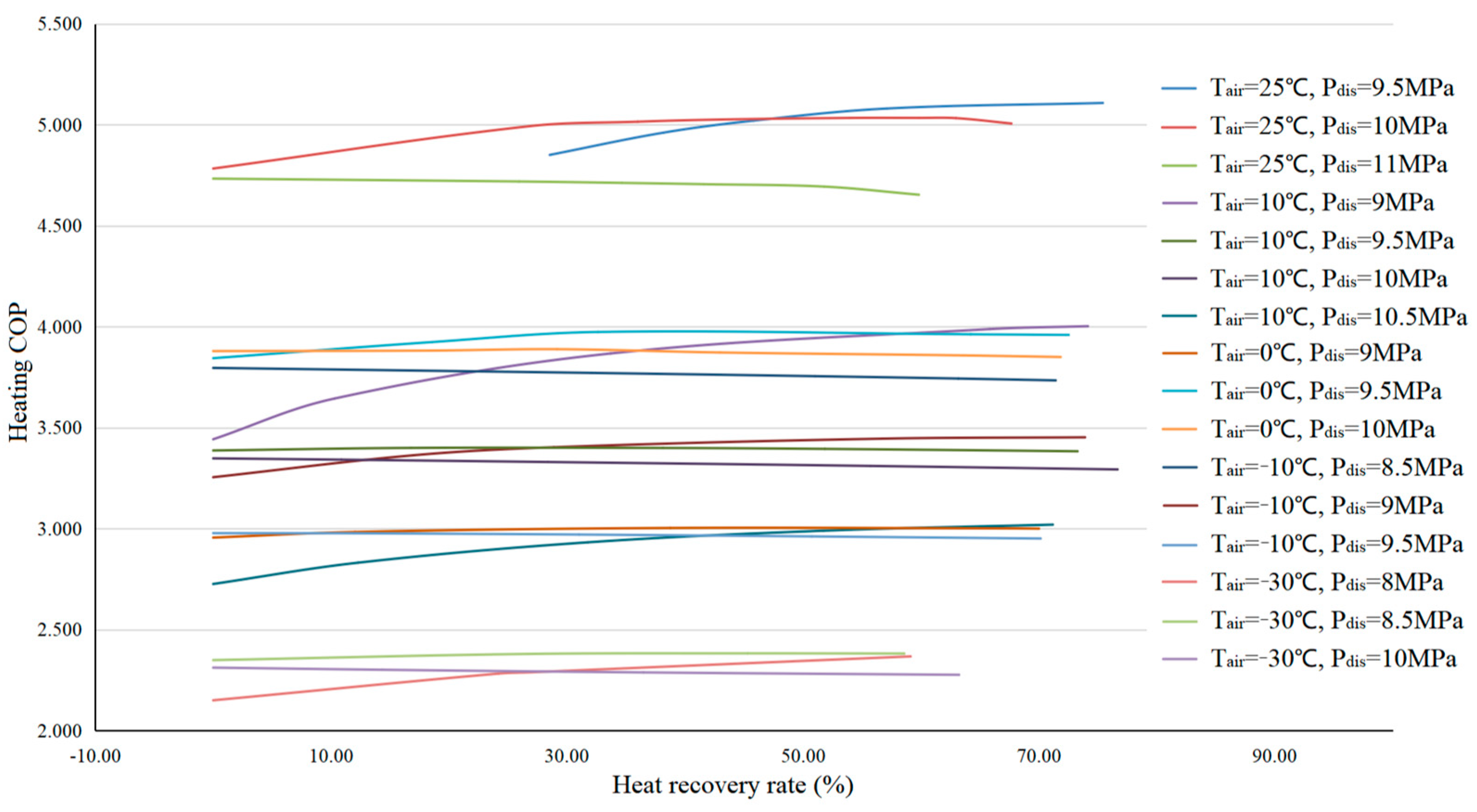
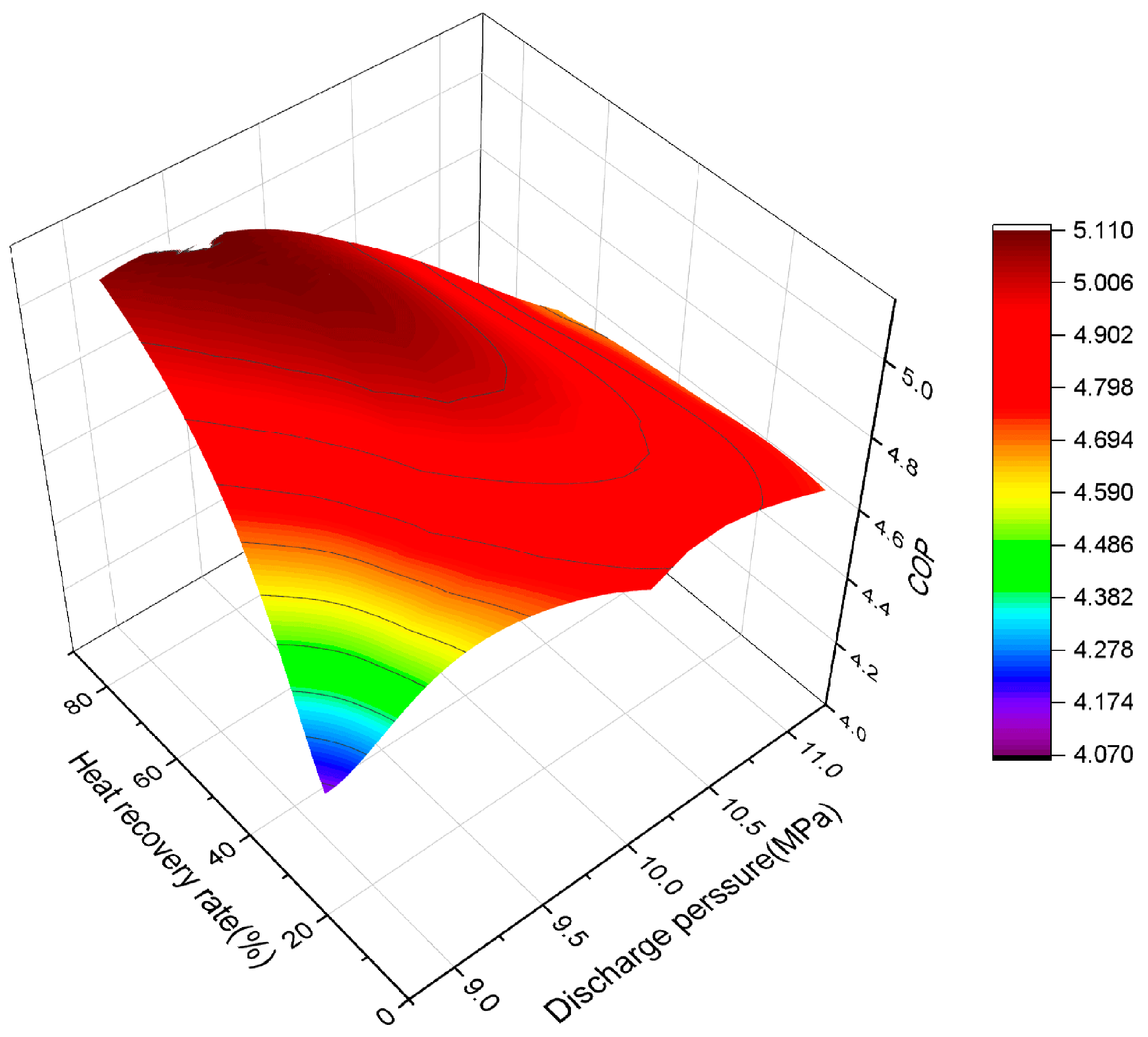

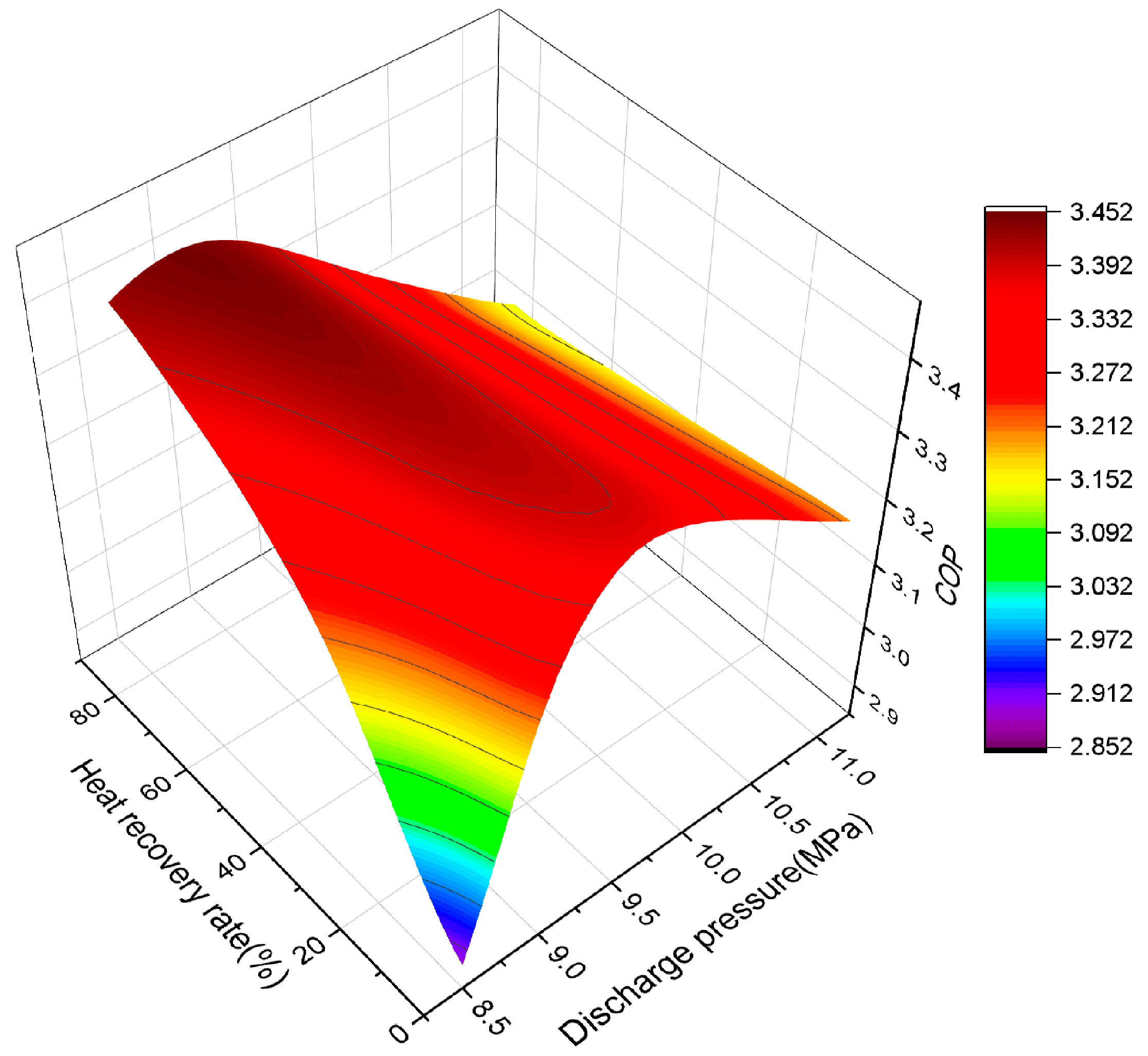
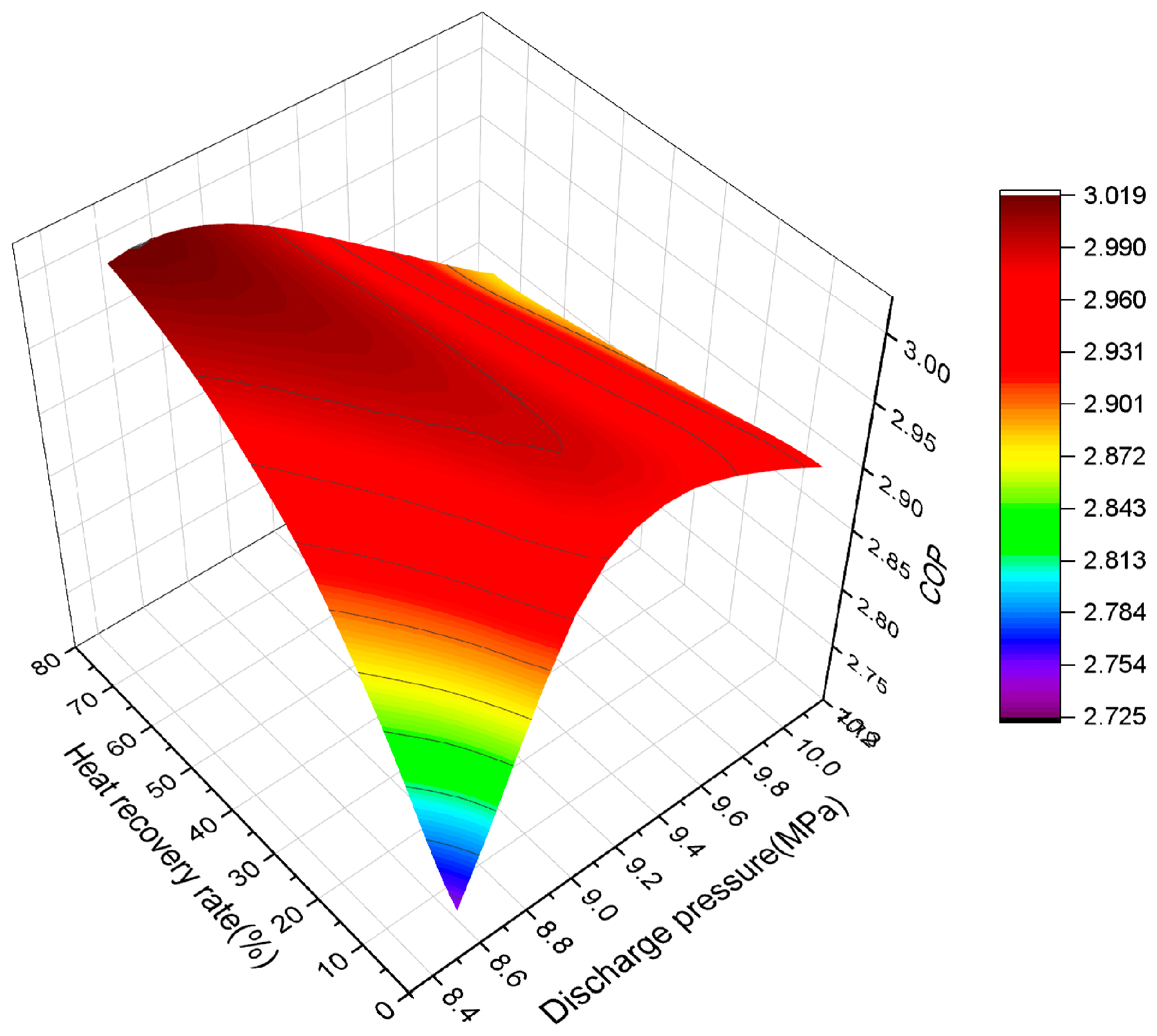
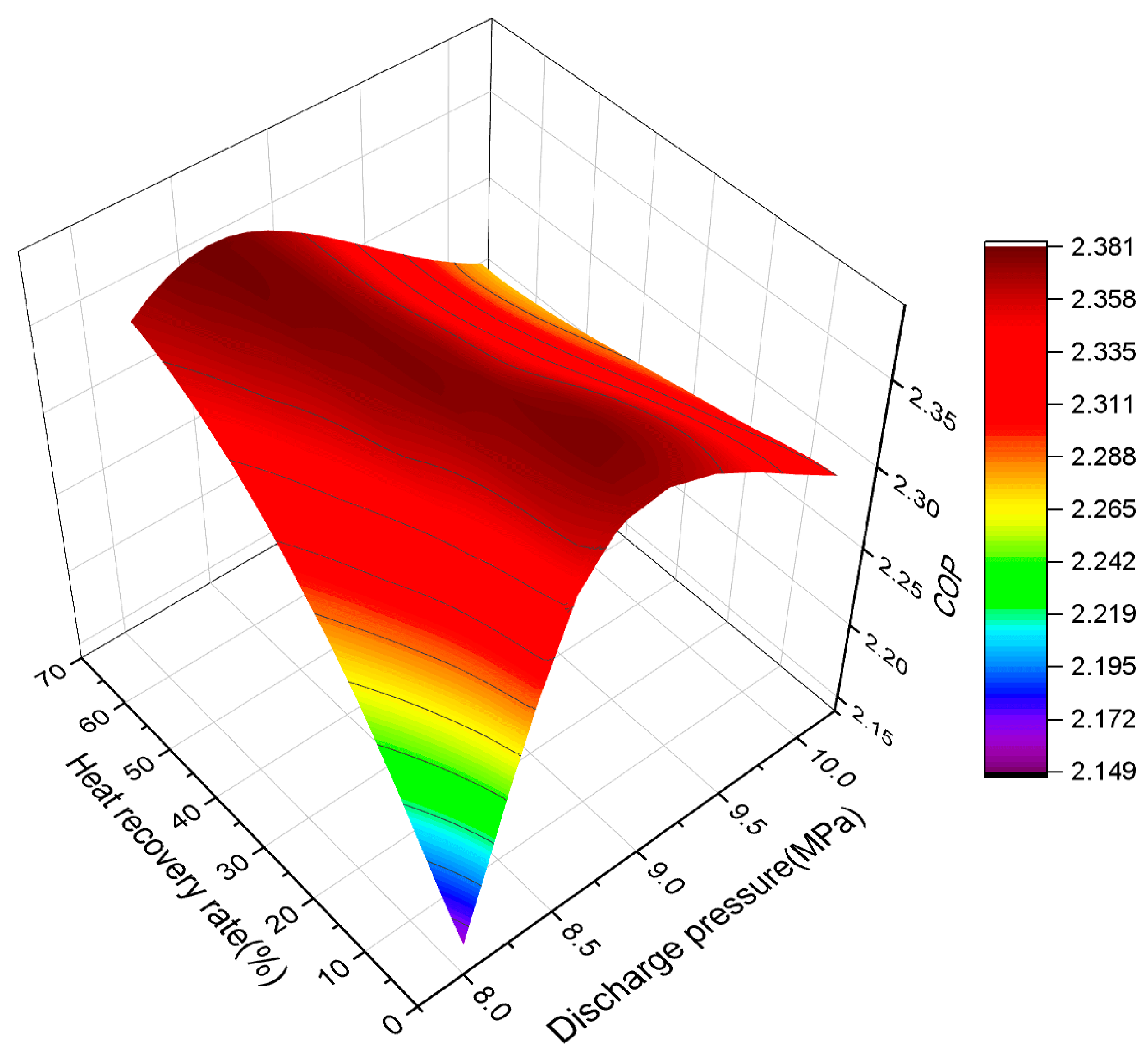
| Components Name | Design Parameters |
|---|---|
| Gas-cooler | Tube and tube heat exchanger; counter flow; three units in parallel; tube length: 38.703 m; refrigerant tube: copper; Φ9.52/Φ8.77 mm; water tube: stainless steel; Φ19/Φ15 mm; heat transfer area: 2.24 m2. |
| Evaporator | Fin and tube heat exchanger; cross flow; copper tubes; tube diameter: 9.52 mm; wall thickness: 0.75 mm; tube length: 2.2 m; fin pitch: 2.4 mm; thickness: 0.2 mm; number of serial tubes: 4; number of parallel tubes per row: 36; Number of circuits: 9. |
| IHX | Tube and tube heat exchanger; counter flow; Outer tube: copper; Φ28/Φ27 mm; inner tube: copper; Φ13/Φ12 mm; heat transfer area: 0.327 m2. |
| Separator | Volume: 9.4 l; height: 300 mm. |
| Components Name | Input Parameter | Output Parameter |
|---|---|---|
| Compressor | Pressure (barA) Density (kg/m3) Rotary speed (rev/min) | Enthalpy flow rate (W) Mass flow rate (kg/s) Torque (Nm) |
| Gas-cooler | Enthalpy flow rate (W) Mass flow rate (kg/s) | Pressure (barA) Density (kg/m3) |
| IHX (High pressure side) | Pressure (barA) Density (kg/m3) | Pressure (barA) Density(kg/m3) |
| EEV | Pressure (barA) Density (kg/m3) | Enthalpy flow rate (W) Mass flow rate (kg/s) |
| Evaporator | Enthalpy flow rate (W) Mass flow rate (kg/s) | Pressure (barA) Density (kg/m3) |
| Separator | Pressure (barA) Density (kg/m3) | Enthalpy flow rate (W) Mass flow rate (kg/s) |
| IHX (Low pressure side) | Pressure (barA) Density (kg/m3) | Pressure (barA) Density (kg/m3) |
Disclaimer/Publisher’s Note: The statements, opinions and data contained in all publications are solely those of the individual author(s) and contributor(s) and not of MDPI and/or the editor(s). MDPI and/or the editor(s) disclaim responsibility for any injury to people or property resulting from any ideas, methods, instructions or products referred to in the content. |
© 2023 by the authors. Licensee MDPI, Basel, Switzerland. This article is an open access article distributed under the terms and conditions of the Creative Commons Attribution (CC BY) license (https://creativecommons.org/licenses/by/4.0/).
Share and Cite
Wu, Z.; Bi, F.; Fei, J.; Zheng, Z.; Song, Y.; Cao, F. The Collaborative Optimization of the Discharge Pressure and Heat Recovery Rate in a Transcritical CO2 Heat Pump Used in Extremely Low Temperature Environment. Energies 2023, 16, 2059. https://doi.org/10.3390/en16042059
Wu Z, Bi F, Fei J, Zheng Z, Song Y, Cao F. The Collaborative Optimization of the Discharge Pressure and Heat Recovery Rate in a Transcritical CO2 Heat Pump Used in Extremely Low Temperature Environment. Energies. 2023; 16(4):2059. https://doi.org/10.3390/en16042059
Chicago/Turabian StyleWu, Zhongkai, Feifei Bi, Jiyou Fei, Zecan Zheng, Yulong Song, and Feng Cao. 2023. "The Collaborative Optimization of the Discharge Pressure and Heat Recovery Rate in a Transcritical CO2 Heat Pump Used in Extremely Low Temperature Environment" Energies 16, no. 4: 2059. https://doi.org/10.3390/en16042059
APA StyleWu, Z., Bi, F., Fei, J., Zheng, Z., Song, Y., & Cao, F. (2023). The Collaborative Optimization of the Discharge Pressure and Heat Recovery Rate in a Transcritical CO2 Heat Pump Used in Extremely Low Temperature Environment. Energies, 16(4), 2059. https://doi.org/10.3390/en16042059






